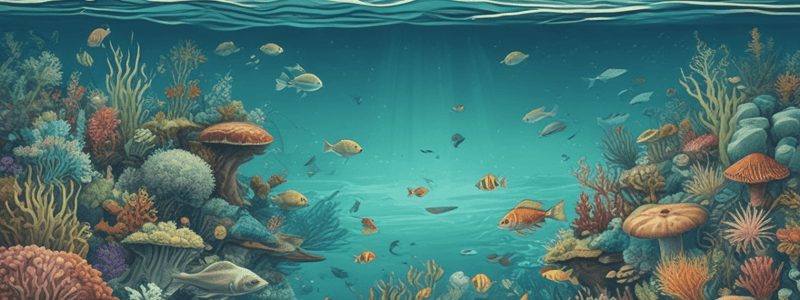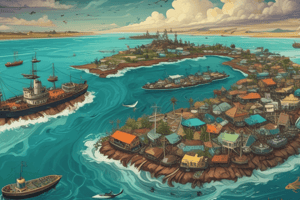Podcast
Questions and Answers
What is the primary characteristic of halophytic plants found in salt marshes?
What is the primary characteristic of halophytic plants found in salt marshes?
- They are only found in coral reefs
- They are only found in freshwater ecosystems
- They are the primary producers of ocean ecosystems
- They are tolerant of salt (correct)
What is the term for the study of ecosystems between the low and high tide lines?
What is the term for the study of ecosystems between the low and high tide lines?
- Estuary ecology
- Marine biology
- Intertidal ecology (correct)
- Lagoon ecology
What is a characteristic of salt marshes that contributes to their high biodiversity?
What is a characteristic of salt marshes that contributes to their high biodiversity?
- Their lack of tidal surges
- The tendency of algae to bloom in shallow water (correct)
- Their ability to support large populations of fish
- Their location at the coast
What is the condition of the intertidal at high tide?
What is the condition of the intertidal at high tide?
What is a common misconception about salt marshes and other wetlands?
What is a common misconception about salt marshes and other wetlands?
What is a type of ecosystem that is often found in bays, estuaries, and lagoons?
What is a type of ecosystem that is often found in bays, estuaries, and lagoons?
What is the primary difference between a lagoon and an estuary?
What is the primary difference between a lagoon and an estuary?
What is a characteristic of bays that distinguishes them from lagoons and estuaries?
What is a characteristic of bays that distinguishes them from lagoons and estuaries?
What is a favorable condition found in estuaries and bays?
What is a favorable condition found in estuaries and bays?
What is a common feature found near estuaries and bays?
What is a common feature found near estuaries and bays?
What is a common use of Lagoons, Estuaries and Bays that is non-extractives?
What is a common use of Lagoons, Estuaries and Bays that is non-extractives?
Which of the following is a source of pollution in Lagoons, Estuaries and Bays?
Which of the following is a source of pollution in Lagoons, Estuaries and Bays?
What is the most common extractive activity in Lagoons, Estuaries and Bays?
What is the most common extractive activity in Lagoons, Estuaries and Bays?
What is NOT a direct anthropogenic threat to Lagoons, Estuaries and Bays?
What is NOT a direct anthropogenic threat to Lagoons, Estuaries and Bays?
What is an ecosystem service provided by Lagoons, Estuaries and Bays?
What is an ecosystem service provided by Lagoons, Estuaries and Bays?
Flashcards
Marine Ecosystem
Marine Ecosystem
Aquatic environments with saltwater, supporting diverse plant and animal life.
Marine Ecosystem Functions
Marine Ecosystem Functions
Crucial for feeding, sheltering, and guiding marine life.
Critical Marine Habitats
Critical Marine Habitats
Salt marshes, coral reefs, and seagrass beds.
Salt Marsh Ecosystem
Salt Marsh Ecosystem
Signup and view all the flashcards
Halophytes
Halophytes
Signup and view all the flashcards
Intertidal Ecosystem
Intertidal Ecosystem
Signup and view all the flashcards
Vertical Zonation
Vertical Zonation
Signup and view all the flashcards
Lagoons, Estuaries, and Bays
Lagoons, Estuaries, and Bays
Signup and view all the flashcards
Lagoons
Lagoons
Signup and view all the flashcards
Estuaries
Estuaries
Signup and view all the flashcards
Bays
Bays
Signup and view all the flashcards
Favorable Conditions in LEB
Favorable Conditions in LEB
Signup and view all the flashcards
Uses of Lagoons, Estuaries, and Bays
Uses of Lagoons, Estuaries, and Bays
Signup and view all the flashcards
Threats to Lagoons, Estuaries, and Bays
Threats to Lagoons, Estuaries, and Bays
Signup and view all the flashcards
Sources of Pollution
Sources of Pollution
Signup and view all the flashcards
Study Notes
Marine Ecosystems
- Marine ecosystems include oceans, salt marshes, intertidal habitats, estuaries, lagoons, mangroves, coral reefs, and the deep sea and sea floor.
- They are contrasted with freshwater ecosystems, which have a smaller salt content.
Characteristics of Marine Ecosystems
- Considered ecosystems because plant life supports animal life and vice-versa.
- Provide fish habitat, food, shelter from predators and competitors, migration routes, and reproduction cues.
- Critical habitats include salt marshes, intertidal ecosystems, lagoons, estuaries, mangroves, beaches, coral reefs, and seagrass beds.
Salt Marsh Ecosystem
- Transitional area between land and salty or brackish water (e.g., sloughs, bays, estuaries).
- Dominated by halophytic (salt-tolerant) herbaceous plants.
- Considered one of the most biologically productive habitats on the planet, rivaling tropical rainforests.
- Tidal surges bring in nutrients, which tend to settle in plant roots, and natural chemical activity of salty water and algae blooms allow for great biodiversity.
Intertidal Ecosystem
- Study of intertidal ecosystems involves interactions between organisms and their environment, as well as between different species within a community.
- Organisms live between low and high tide lines, with exposure at low tide and immersion at high tide.
- Vertical zonation is a key characteristic of intertidal ecosystems.
Lagoons, Estuaries, and Bays
- Shallow, semi-enclosed, and sheltered littoral bodies of water.
- Lagoons: semi-enclosed coastal basins with limited freshwater input, high salinity, and restricted circulation.
- Estuaries: semi-enclosed coastal basins where freshwater from rivers mixes with saline water from the ocean.
- Bays: more open littoral basins with flow not as restricted and salinity levels approaching the open sea.
- Favorable conditions in these ecosystems include a wide range of salinity, near total light penetration, large quantities of organic nutrients, and high rates of vertical mixing.
Uses and Threats to Lagoons, Estuaries, and Bays
- Uses: harbors, disposal sites, recreation, science and education, aquaculture, transport, fishing, sand mining, seed fish and shrimp collection, ornamental fish collection, gleaning, and desalination.
- Threats: pollution from domestic sewage waste, domestic solid waste, sediments from erosion and construction, mine tailings, industrial organic and toxic wastes, agricultural chemicals, oil and fuel leaks, and landfills.
Studying That Suits You
Use AI to generate personalized quizzes and flashcards to suit your learning preferences.



